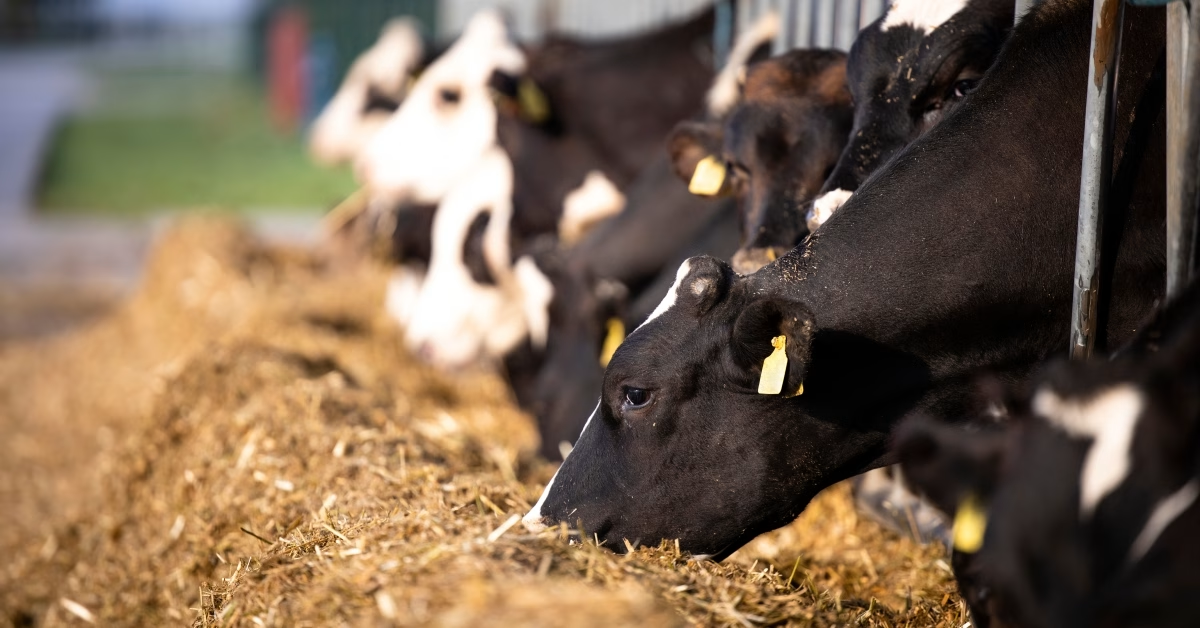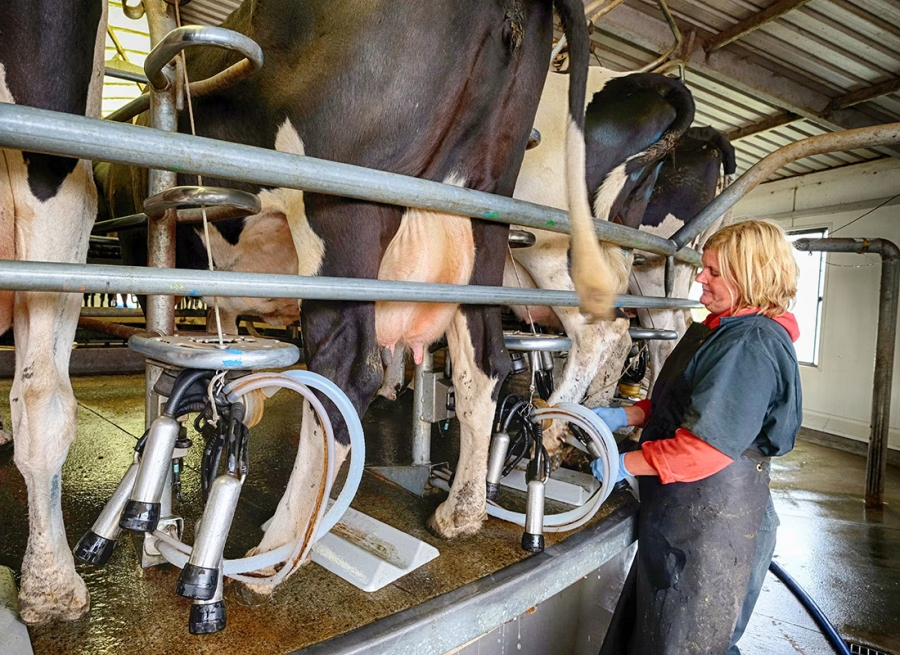Find out how forage quality affects cattle feeding behavior and productivity. Learn practical ways to measure and improve your herd’s performance. Interested? Read on.

Within the intricate realm of dairy production, fodder quality is a pivotal pillar for animal welfare and output. Even slight alterations in a cow’s eating pattern can significantly impact its well-being and productivity. The cattle’s standard digestion and overall health hinge on feeding behavior, including eating time, sorting, and rumination. The direct influence of forage quality on these activities determines the efficiency of livestock in converting feed into milk and meat. Farmers and dietitians can make informed decisions to enhance cow health and agricultural efficiency by delving into these dynamics. Join us as we dissect how feeding behavior is shaped by pasture quality, thereby influencing cow production and welfare.
The Comprehensive Nuances of Forage Quality
Key elements in forage quality include physical traits and nutritional value. Nutritive value pertains to minerals, proteins, vitamins, and carbohydrates—essential nutrients. Good-quality fodder guarantees these nutrients satisfy ruminants’ dietary requirements.
Physical properties like particle size, texture, and moisture content influence the ease of consumption and digestion. Fiber digestibility, which encompasses elements like lignin and cellulose, is a key component. High fiber digestibility allows ruminants to maximize the nutritional content of the fodder.
Fermenting quality also depends on maintaining silage and improving its palatability and digestibility. Well-fermented forage reduces spoilage and maintains better nutritional content, supporting animal health and production.
Different forages have different qualities; examples of such range corn silage and sorghum silage. Usually having better fiber digestibility and a more effective neutral detergent fiber (NDF) percentage, corn silage helps to support extended eating time and effective rumen fermentation. On the other hand, sorghum silage often contains less digestible fiber, which requires lengthier mastication and animal sorting to satisfy dietary demands. Its less desired fermentability could influence palatability and nutritional preservation.
Decoding the Intricacies of Cattle Feeding Behaviors: Eating Time, Sorting, and Rumination
They demonstrate essential feeding habits for cattle digestion and health. These include sorting, feeding times, and rumination.
Eating Time: Cattle spend this time at the bunk chewing feed. Longer eating times imply that they evaluate and choose feed, improving nutritional consumption. Longer eating times increase salivary flow, which helps fermentation and buffers rumen pH.
Cattle sort their feed to choose specific components, affecting the nutritional balance of their diet. Eating grains instead of roughage will help avoid digestive problems like acidosis. Forage quality affects sorting; more appealing forages help minimize this tendency.
Rumination, often known as cud-chewing, is food regurgitated and re-chewed. Broken-down forage and effective digestion depend on this. Every cud chew increases saliva-containing bicarbonates that balance rumen pH and neutralize stomach acids. Furthermore, improving rumen motility helps pass.
Feeding behavior is based on resting time, representing a cow’s total time budget. Enough slumber allows for sufficient stress management and rumination. Lack of rest might indicate problems with barn management or feed quality, lowering feed efficiency and milk output. Monitoring and adjusting feeding behavior and enough rest increase cow welfare and production.
Embracing Cutting-Edge Technologies to Measure and Enhance Cattle Feeding BehaviorModern technology provides a range of practical tools to track essential facets of cattle’s daily activities. These include sensors, ear tags, pedometers, and collars. For instance, pedometers can monitor eating and resting habits, providing complete activity data, while ear tags with accelerometers measure rumination via jaw motions.
Emerging camera systems in barns and advanced software can forecast eating times and sorting actions, providing exciting future developments in cattle feeding behavior monitoring. When fully developed, these tools will provide even more comprehensive data for producers and dietitians.
These instruments provide dietitians and producers with practical knowledge. By tracking these activities, one might find variations in eating habits that suggest variations in fodder quality. This enables prompt actions to preserve herd health and production by changing feeding plans, diet adjustments, or new management techniques.
Adopting a Proactive Approach to Cow Management through the Use of Various Measuring Technologies
Understanding the Impact of Forage Quality on Feeding Behavior: Key to Optimizing Cattle Productivity and Welfare
Maximizing cow production and welfare depends on an awareness of how forage quality affects feeding behavior. Comparatively to cattle diets of corn silage vs sorghum silage, recent studies show notable variations in feeding behavior. Spending between 85 and 95 percent of their feeding period digesting this fodder, cows are given maize silage—with a higher digestible neutral detergent fiber (NDF) fraction—spaced around. By comparison, cows given sorghum silage—which has less digestible fiber—spent between 105 and 110% of their feeding time at the feed bunk. This shows that fodder quality highly influences eating behavior, especially fiber digestibility.
Leading causes of these variations include sorting behavior and mastication time. Because corn silage is more digestible, cows need less mastication and may more quickly get their needed intake. On the other hand, the stiffer fiber of sorghum silage requires more extended chewing and rumination to lower the bolus to a reasonable size for digestion. Moreover, cows show selective eating habits; they regularly sift their food to pick more acceptable parts. The less tasty quality of sorghum silage causes cows to spend more time sorting; this contrasts significantly with the more equally digested corn silage.
These results highlight the complex relationship between forage quality and feeding behavior, stressing the importance of cautious forage choice and management to guarantee the best animal performance and welfare. Regarding feeding time and behavior, usage quality becomes a significant factor for farmers trying to improve cattle production and welfare.
Actionable Strategies for Producers to Monitor and Enhance Forage Quality
Producers trying to monitor and improve fodder quality must have practical plans. Regular forage testing is vital first. Quick, reliable evaluations of forage nutrients made possible by tools like NIRS (Near-Infrared Spectroscopy) help guide feeding plans. Early identification of variations in feed quality can enable remedial action before they affect cattle performance.
Seeing feeding behavior provides more information than just testing. Variations in feeding times, sorting methods, and rumination point to changes in fodder quality. Cattle that spend too much time at the feed bunk or shun certain forages, for instance, may indicate problems with palatability or digestibility. Similarly, a shortened rumination period might indicate insufficient fiber content or poor feed quality.
Modern sensor technology lets producers track these trends. Real-time data from devices such as pedometers, collars with accelerometers, and ear tags track activity levels, feeding length, and rumination, thereby guiding management choices. These tools identify minute behavioral changes indicating declining fodder quality or animal health problems, therefore serving as early warning systems.
A dynamic approach—regular testing, constant monitoring, and quick changes—helps maximize cattle production and welfare. Producers can guarantee their herds get ideal nutrition by knowing and reacting to the interaction between forage quality and eating behavior, improving health and performance.
The Bottom Line
Ultimately, forage quality powerfully shapes cattle grazing behavior, production, and welfare. Our research reveals how fodder quality—physical characteristics and nutritional value—affects cattle’s feeding time, sorting, and rumination. For forages like corn silage, high-fiber digestibility sets off different feeding patterns than less digestible choices like sorghum silage. Producers trying to maximize herd welfare and production need this awareness.
The development of sophisticated technology, such as sensors and future camera systems, provides encouraging means to track eating patterns more accurately. These instruments provide farmers with real-time insights into feeding and rumination, helping them spot problems with fodder quality before they become more serious.
Essential investments are in modern monitoring technologies and premium forages. Producers should welcome these developments for more effective, healthy herds. Improving feed quality and using contemporary technology will help the agricultural industry ensure cattle survival and flourish, guaranteeing a sustainable and profitable future in cow farming.
Key Takeaways:
- Feeding behavior encompasses eating time, sorting, and rumination — critical factors influenced by the quality of forage.
- Variations in forage quality, particularly between corn silage and sorghum silage, significantly impact cattle’s time spent at the feed bunk and their overall feeding patterns.
- High-quality forage with greater fiber digestibility encourages more efficient feeding behaviors, ultimately enhancing cows’ productivity.
- Monitoring techniques: Modern technologies like sensors, pedometers, and collars are essential for measuring and understanding cattle feeding behaviors.
- Producers can potentially identify forage quality issues through changes in cattle’s resting and rumination periods, leading to timely adjustments and improvements in forage management.
- The interplay between forage quality and feeding behavior holds the key to improving both the performance and welfare of dairy herds, marking an area ripe for further research and innovation.
Summary:
Fodder quality is crucial in dairy production as it influences livestock’s efficiency in converting feed into milk and meat. Physical traits and nutritional value, such as particle size, texture, and moisture content, influence consumption and digestion. Fiber digestibility is essential for ruminants to maximize fodder nutritional content. Fermenting quality depends on maintaining silage and improving its palatability and digestibility. Eating time, sorting, and rumination are essential feeding habits for cattle digestion and health. Longer eating times indicate better nutritional consumption and prevent digestive problems like acidosis. Sorting affects the nutritional balance of the diet, and rumination affects broken-down forage and digestion. Monitoring and adjusting feeding behavior and resting time improve cow welfare and production.












